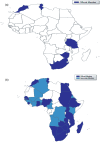Specific features of medicines safety and pharmacovigilance in Africa
- PMID: 25083223
- PMCID: PMC4110828
- DOI: 10.1177/2042098611425695
Specific features of medicines safety and pharmacovigilance in Africa
Abstract
The thalidomide tragedy in the late 1950s and early 1960s served as a wakeup call and raised questions about the safety of medicinal products. The developed countries rose to the challenge putting in place systems to ensure the safety of medicines. However, this was not the case for low-resource settings because of prevailing factors inherent in them. This paper reviews some of these features and the current status of pharmacovigilance in Africa. The health systems in most of the 54 countries of Africa are essentially weak, lacking in basic infrastructure, personnel, equipment and facilities. The recent mass deployment of medicines to address diseases of public health significance in Africa poses additional challenges to the health system with notable safety concerns. Other safety issues of note include substandard and counterfeit medicines, medication errors and quality of medicinal products. The first national pharmacovigilance centres established in Africa with membership of the World Health Organization (WHO) international drug monitoring programme were in Morocco and South Africa in 1992. Of the 104 full member countries in the programme, there are now 24 African countries with a further nine countries as associate members. The pharmacovigilance systems operational in African countries are based essentially on spontaneous reporting facilitated by the introduction of the new tool Vigiflow. The individual case safety reports committed to the WHO global database (Vigibase) attest to the growth of pharmacovigilance in Africa with the number of reports rising from 2695 in 2000 to over 25,000 in 2010. There is need to engage the various identified challenges of the weak pharmacovigilance systems in the African setting and to focus efforts on how to provide resources, infrastructure and expertise. Raising the level of awareness among healthcare providers, developing training curricula for healthcare professionals, provisions for paediatric and geriatric pharmacovigilance, engaging the pharmaceutical industries as well as those for herbal remedies are of primary concern.
Keywords: Africa; adverse drug reactions; medicines safety; pharmacovigilance.
Conflict of interest statement
The authors declare no conflicts in preparing this article.
Figures
References
-
- Ali L., Benkirane R., Soulaymani R. (2007) Detecting medication errors in pharmacovigilance database: capacities and limits. Int J Risk Saf Med 19: 1–18
-
- Dodoo A., Adjei S., Couper M., Hugman B., Edwards R. (2007) When rumours derail a mass deworming exercise. Lancet 370: 465–466 - PubMed
-
- Hetherington S., Hughes A.R., Mosteller M., Shortino D., Baker K.L., Spreen W., et al. (2002) Genetic variations in HLA-B region and hypersensitivity to abacavir. Lancet 359: 1121–1122 - PubMed
Publication types
LinkOut - more resources
Full Text Sources
Miscellaneous


